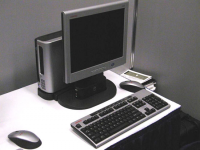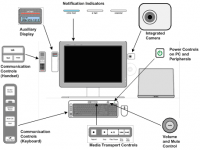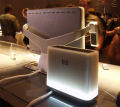Athens PC
The "Athens" PC was a prototype personal computer developed between 2002 and 2004 by Hewlett-Packard in collaboration with the Microsoft Corporation for the Microsoft Windows "Longhorn" operating system.
History
"Agora" PC
Development of the "Athens" PC began as a collaborative effort between Hewlett-Packard and Microsoft known as the "Agora" PC. "Agora" was designed to be a real time communications device for business and was demonstrated by HP at the COMDEX computer exposition in 2002 as an extension of the company's e-PC series of small form factor computers.[1] "Agora" included a flat-panel LCD display monitor which housed expansion ports, speakers, and an optical disc drive at the base of the unit, wireless peripheral devices powered by Bluetooth technology, and integrated telecommunication hardware. To demonstrate the capabilities of the machine, a video was displayed during COMDEX which showed a user of "Agora" using Windows Messenger to conduct a video conference with a prototype device which used several cameras to display a 360-degree panorama; the video also showed the user collaborating on documents with other "Agora" users in real time.[1] While previous PCs had already included much of the functionality of "Agora" through the use of supplementary hardware and software, "Agora" was designed to bring all of the functionality together without requiring additional products or services.
"Athens" PC
In 2003, "Agora" was succeeded by a new prototype PC called the "Athens." This new PC was based on the previous prototype's design and included several new hardware features, such as LED lights on the top of the display monitor to alert the user of events, including a new voicemail, e-mail, or an upcoming appointment. Microsoft publicly demonstrated "Athens" for the first time during its Windows Hardware Engineering Conference of 2003 (WinHEC 2003).[2][3][4] Chad Magendanz, Lead Program Manager, Hardware Innovation Group, gave the demo.[5]
After WinHEC 2003, there were claims that the company was deliberately imitating its competitor Apple in the areas of hardware design and software features.[6] Speaking of the then-new desktop compositor in Microsoft's Windows "Longhorn," Phillip Schiller, then vice president of Apple marketing, stated that the technology was "almost a direct copy of Quartz," referring to Apple's own composition technology.[7]
The "Athens" PC would later be featured at the Professional Developers Conference of 2003 during Hillel Cooperman's presentation titled Get Users to Fall in Love With Your Software.[8]
New PC designs based on "Athens" were unveiled during WinHEC 2004.[9] "Hermes", a new mobile PC prototype, featured a wireless display unit designed for activities such as presentations, and also featured integrated web camera. "Troy", a new business PC prototype, included an integrated dock for a personal digital assistant (PDA) which allowed it to be used as a secondary display. "Troy" also made changes based on feedback received after the "Athens" was unveiled, such as relocating various hardware controls previously featured on the "Athens" keyboard into the base of the main display monitor. According to HP's Brian Schmitz, the "Troy" PC would be the last major PC prototype unveiled before the company would release a shipping product.[10]
In 2005, Microsoft stated that it had made progress towards its "Athens" vision with the new features included in its Windows Vista (then codenamed "Longhorn") operating system, with features such as support for microphone array processing technology, new audio features and glitch-free playback powered by a new audio subsystem, and improvements to the native Windows Bluetooth subsystem; the company also stated that many aspects of its "Athens" vision were realized in the new features included with its Office Communicator 2005 and Office Live Communications Server 2005 products.[11] Elements of the "Athens" PC would later reemerge in prototype personal computers developed by the Carbon Design Group for Microsoft's Windows Vista operating system.[12][13]
Although the "Athens" and subsequent PC prototypes were not released, Microsoft employee M3 Sweatt wrote in 2012 that most of the hardware predictions he made when "Athens" was in development had come to pass as technology advanced.[14]
Magendanz, who demoed "Athens" at WinHEC 2003 commented on his upload of his demo on YouTube:
Well, I just bought an ASUS 27" IPS LED display for $109 AR and mounted an $86 Quad Core Intel Atom x5-Z8350 64-bit Windows 10 mini PC on the back. The short HDMI cable does video and audio, and I use Bluetooth 4.0 for the wireless keyboard and mouse, plus my headset for Skype conferencing. Mission accomplished, and at a much lower price point than we expected.
— Chad Magendanz, Chad Magendanz demos Athens at WinHEC 2003, [15]
The Your Phone app in Windows 10 allows a user to make and receive calls from an Android device through a Bluetooth connection,[16] partially fulfilling a broader goal for the "Athens" PC of a Bluetooth solution for a phone-PC connection that Magendanz described on his WinHEC 2003 demo.[5]
Design
The "Athens" PC is essentially an "all-in-one PC" in that it integrates most of the components traditionally encased within a desktop PC inside the case of its display monitor. A cable connects the display monitor to the main unit of the machine which houses a central processing unit (CPU) and other components.
Magendanz described "Athens" in his WinHEC 2003 demo as:
Well, it's my pleasure to introduce you today to our vision of the future business desktop, a collaborative effort between Microsoft and Hewlett-Packard codenamed "Athens".
Now the most striking feature about "Athens" when you first walk up is a display: wide, high-density, flat. It really has obvious consumer appeal but we're seeing dramatic productivity benefits with a display of this type as well. Both in our internal and third-party research, for example, we're seeing a 30% improvement on time and tasks with large displays. We're also seeing a 17.4% improvement in reading speed with high-density displays, so there's some real productivity value in here for enterprises. But at what cost? Obviously a display like this would cost over $2,000 right now. Fortunately, display search projections show that a 20-inch version of the same resolution display will have an average selling cost of less than $400 in the year 2004.
One of things that's less obvious about this play is the work that's gone into consolidating a lot of the components and cables that normally clutter your desktop within the display itself. This one cable from the CPU which contains high speed USB and video connects a slim form factor drive bay, USB speakers, two element array microphone, camera, and a Bluetooth transceiver that drives this rechargeable wireless keyboard that recharges right here in the base, wireless mouse, and a cordless telephone handset. By pulling the elements of the PC that the user normally interacts with into the display console, we make it easier to more independently support and update the CPU and the peripherals. We're really preserving the value, the hardware investment in the peripherals themselves. In the process, we can substitute the CPU with a dock so that laptop and tablet users can achieve the same no compromise desktop productivity experience and sacrifice nothing for the mobility.
"Athens" also represents some long-term investments we've been making in the Windows System architecture to improve power management and security. For example, when I'm not using this machine, it normally powers down to this state. This standby state alone cuts power usage in the enterprise desktop by about 78%, which represents about a $95 per unit per year savings. Now just because it's in the standby state doesn't mean that it's not totally manageable. In fact, I can still use the phone and the notification lights I have here. So when I walk across the room returning from my meeting, I see immediately whether I've got outstanding voicemail, email, or an upcoming appointment.
Now just because I can walk up and have the machine ready to go in less than two seconds doesn't mean we're done yet. We have to streamline the authentication process. I have here a flash drive that actually has an integrated smart card chip and a biometric sensor, so not only do I carry my documents around with me, but I carry my secure, I carry them securely and I insert it just like I would insert the key to my car, and the PC comes on automatically. I just press my thumb to the sensor and I've restored my working environment.
Now a few notes this is prototype software as well as hardware. Hewlett-Packard and Microsoft have been refining and designing "Athens" as a system concurrently developing hardware and software and dramatically shortening the feedback loop to ensure that the end-user is never the first system integration point. These prototyping tools really help us exercise the hardware and software integration. So for example, I know I could pick up a handset and make a phone call in the normal way, but with the PC in the equation, I can use voice dialing or I can select a contact directly from the list. But our broader goal is to work with a wide variety of telephony devices and telephone services, whether it's the analog phone that I've had in my basement for three years, or an enterprise PBX system like this handset from EAS telecom, or a Bluetooth solution like this off-the-shelf Sony Ericsson phone, this prototype Bluetooth smart phone, or this prototype PC, Pocket PC phone edition from Texas Instruments, that not only integrates Bluetooth but Wi-Fi as well. The goal here is to have a consistent user experience and a consistent set of application interfaces that really abstract the complexity of the telephony integration solution from the user and from the application developer. So I can't show you all of these integration scenarios, scenarios during the keynote today, but we have working demos of practically all of these up in the innovation room and I encourage you to stop by this after room afternoon, room 265, and experience them for yourself.
— Chad Magendanz, Chad Magendanz demos Athens at WinHEC 2003, [5]
Gallery
References
- ↑ 1.0 1.1 Hachman, Mark. (November 20, 2002). "HP, Microsoft Crafting 'Communications PC'"
- ↑ Microsoft PressPass. (May 6, 2003). "Bill Gates Unveils Next Wave of Windows PC Innovation at WinHEC 2003"
- ↑ Thurrott, Paul. (May 5, 2003). "WinHEC 2003: Microsoft, HP Unveil 'Athens' PC"
- ↑ Dudley, Brier. (May 6, 2003). The Seattle Times - "Microsoft 'Athens' built on strategy for new PC golden age"
- ↑ 5.0 5.1 5.2 Magendanz, Chad (28 May 2012). Chad Magendanz demos Athens at WinHEC 2003. Retrieved on 12 April 2021.
- ↑ Seward, Vern. (May 11, 2003). "NY Times Quotes Apple Exec On Microsoft’s 'Athens' PC Prototype"
- ↑ Markoff, John. (May 12, 2003). "Apple Tweaks Microsoft Over a New Computer"
- ↑ Zheng, Long. (April 14, 2007). “'Getting Users to Fall in Love with Your Software' videos from PDC 2003"
- ↑ Microsoft PressPass. (May 3, 2004). "Q&A: 'Athens' Prototype PC Inspires Innovations Showcased at WinHEC 2004"
- ↑ Hachman, Mark. (May 4, 2004). "Microsoft, HP Unveil New PC Designs"
- ↑ Microsoft PressPass. (April 25, 2005). "Concept PCs Continue to Shape the Future of Computing"
- ↑ Carbon Design Group. "Consumer Product Case Studies"
- ↑ Zheng, Long. (September 17, 2007). "Revisiting Microsoft's 'Vista PC' concept"
- ↑ Sweatt, M3. (January 3, 2012). "A past look at future tech: thoughts on the Windows PC of 2008 back in 2003... and 2012's in 2008"
- ↑ Magendanz, Chad (4 years ago (as of access date)). Chad Magendanz demos Athens at WinHEC 2003. Retrieved on 12 April 2021.
- ↑ Setting up calls in the Your Phone app. Microsoft. Retrieved on 12 April 2021.
External links
Documentation
Videos
- Chad Magendanz demonstrating the "Athens" PC at WinHEC 2003
- AERO Feel (with "Athens" PC) Video
- "Agora" Video (COMDEX 2002)
- "Athens" Business Concept Video
- "Athens" Keynote (WinHEC 2003) Video
- "Athens" Rendered Flyby Version 2.0 Video
- WinHEC 2003 "Athens" CNET Video
- WinHEC 2003 "Athens" Keynote Video
- WinHEC 2003 "Athens" PC Television Broadcast Highlights












